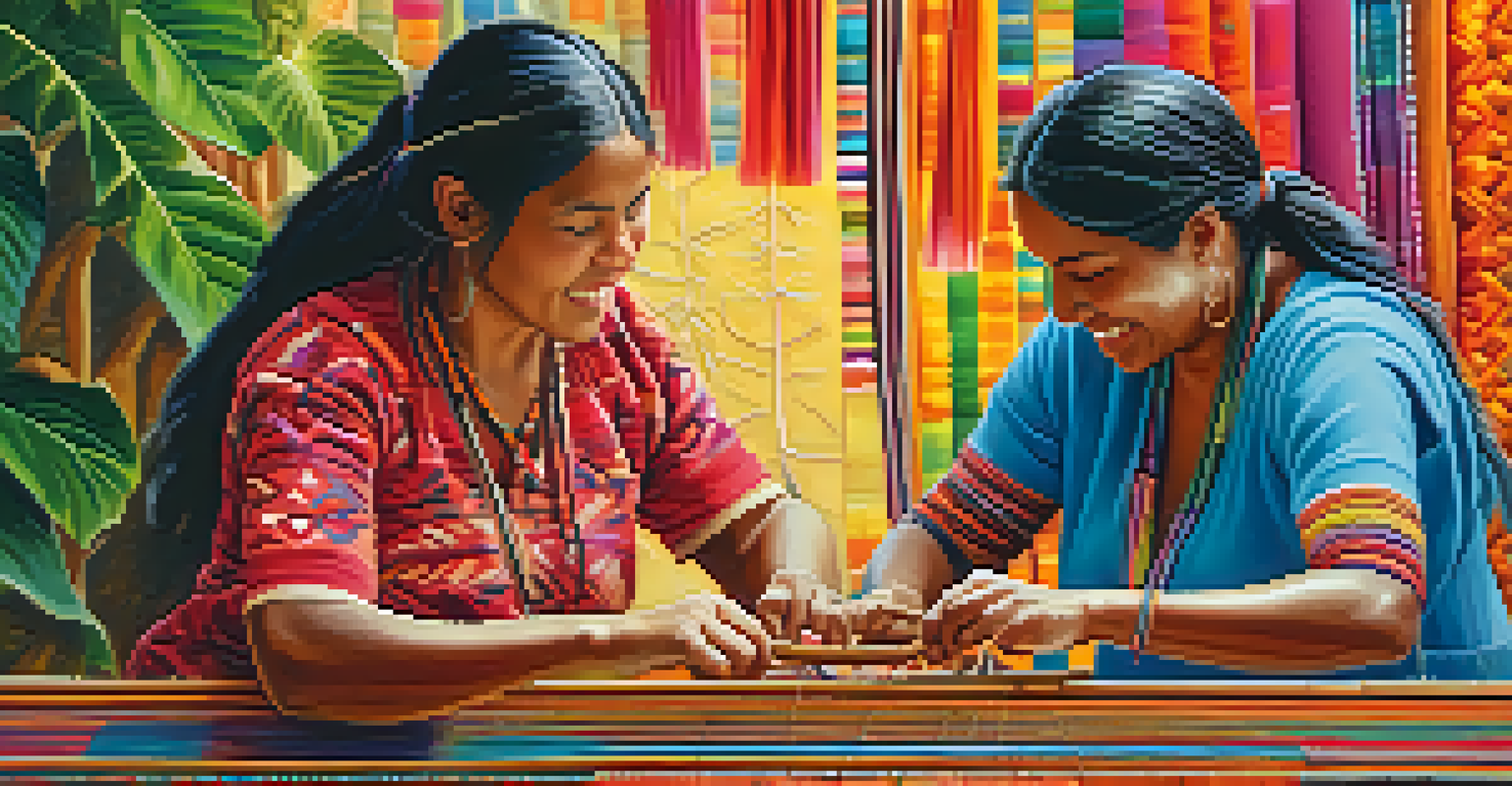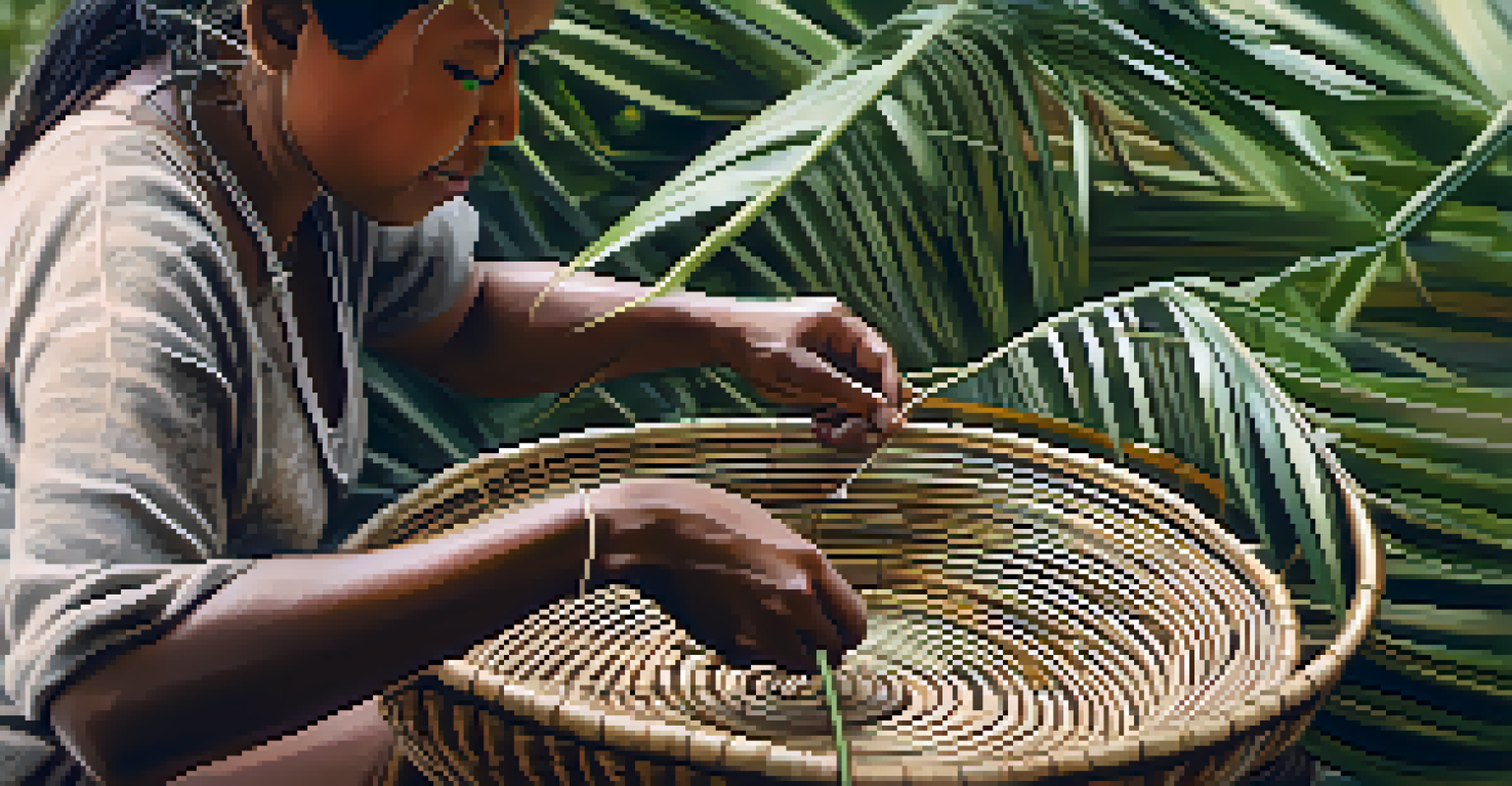Traditional Crafts of Brazil's Indigenous Peoples

Introduction to Indigenous Crafts in Brazil
Brazil's indigenous peoples boast a rich tapestry of traditional crafts that reflect their diverse cultures and histories. From the Amazon rainforest to the Pantanal wetlands, these crafts are not just artistic expressions but also integral to the communities' identities and survival. They form a vital part of their cultural heritage, often passed down through generations.
Art is a reflection of the culture and identity of a people.
Many of these crafts utilize natural materials, showcasing the deep relationship indigenous peoples have with their environment. For example, artisans might use clay from riverbanks, fibers from palm leaves, or vibrant dyes from local plants. This sustainable approach not only preserves their traditions but also respects the earth, exemplifying a harmonious way of life.
As modernization encroaches upon these communities, the importance of preserving these crafts grows. Supporting indigenous artisans helps maintain their cultural practices and promotes a deeper understanding of their worldviews. Thus, exploring these crafts is an invitation to appreciate the rich narratives they carry.
Pottery: The Art of Shaping Earth
Pottery is one of the oldest crafts among Brazil's indigenous peoples, with techniques that date back thousands of years. Each piece tells a story, often adorned with intricate designs that bear cultural significance. For instance, the Xavante people create pottery that reflects their connection to the cosmos, using symbols that represent celestial bodies.

The process of making pottery is labor-intensive, involving collecting clay, shaping it by hand, and then firing it in open flames. This traditional method not only produces beautiful functional items but also fosters community bonds as artisans often work together during these processes. The end product is a tangible representation of their skills and cultural heritage.
Rich Heritage of Indigenous Crafts
Brazil's indigenous crafts reflect diverse cultures and histories, showcasing their connection to nature and identity.
In recent years, there has been a resurgence of interest in indigenous pottery, with many artisans receiving recognition for their craftsmanship. This renewed appreciation not only supports these artists but also educates the broader public about the importance of preserving traditional practices. Pottery stands as a powerful symbol of identity and continuity for many indigenous communities.
Weaving: Threads of Tradition
Weaving is another significant craft among Brazil's indigenous peoples, with techniques varying widely from one tribe to another. Many indigenous groups, such as the Guarani, create intricate textiles using traditional looms, often incorporating vibrant colors and patterns that convey cultural stories or spiritual beliefs. These textiles serve not only as clothing but also as expressions of identity.
Craftsmanship is a bridge between the past and the future.
The materials used for weaving often come from the natural surroundings, showcasing the artisanal skill in sourcing and processing fibers. For example, the use of cotton and other plant-based fibers is common, and the dyeing process often utilizes natural pigments derived from plants and minerals. This eco-friendly approach highlights the deep respect these communities have for their environment.
Weaving also plays a vital role in community life, with many women passing down techniques to younger generations. This transfer of knowledge is essential for preserving cultural heritage, ensuring that traditional practices endure even in the face of modern challenges. Each woven piece is thus a celebration of resilience, creativity, and connection to ancestry.
Basketry: Crafting Nature's Bounty
Basketry is a craft that holds great significance for many indigenous groups in Brazil, providing both utilitarian and artistic value. Indigenous artisans skillfully weave baskets from a variety of natural materials, such as palm fronds, grasses, and vines. These baskets serve practical purposes, from carrying goods to storing food, while also displaying exquisite designs.
The process of creating a basket often involves gathering materials from the surrounding environment and preparing them through techniques like soaking and drying. This not only showcases the artisan's skill but also reflects a sustainable approach to resource management. Each basket is a testament to the artisan's relationship with nature and their commitment to preserving cultural practices.
Challenges to Artisan Traditions
Contemporary issues like deforestation and urbanization threaten the preservation of traditional crafts and the communities that create them.
As interest in traditional crafts grows, basketry is gaining recognition both locally and internationally. Supporting these artisans helps sustain their communities and encourages the continuation of these vital traditions. Through basketry, indigenous peoples express their identity, resilience, and connection to the land.
Body Paint and Ornamentation: Cultural Expressions
Body paint and ornamentation are essential aspects of many indigenous cultures in Brazil, often used during ceremonies, rituals, and festivals. These practices involve the use of natural pigments sourced from plants, minerals, and even insects, creating vibrant colors that hold deep meanings. For instance, specific colors may signify status, roles, or connections to nature.
The application of body paint is often a communal activity, fostering bonds among participants. This shared experience not only strengthens cultural ties but also serves as a way to educate younger generations about their heritage. The designs created can vary greatly, with each tribe having unique patterns that tell their own stories.
As the world becomes more interconnected, there is a growing interest in understanding the significance of body paint and ornamentation. This cultural expression not only beautifies but also embodies the values, beliefs, and histories of indigenous peoples. By appreciating these practices, we promote respect for their traditions and the messages they convey.
Carving: Transforming Wood into Art
Carving is a revered craft among Brazil's indigenous peoples, where artisans transform wood into intricate sculptures, masks, and tools. Each carved piece is often imbued with spiritual significance, reflecting the beliefs and stories of the community. For example, the Tupi people create masks that are used in ceremonies, representing ancestral spirits and connecting the living to the past.
The materials used for carving are typically sourced from the surrounding forests, emphasizing a sustainable approach to resource use. This practice requires not only skill but also a deep understanding of the wood's properties, as different types yield different results. The process of carving itself can be a meditative practice, allowing artisans to connect with their cultural roots.
Importance of Supporting Artisans
Promoting and purchasing indigenous crafts not only sustains these communities but also enriches our understanding of their cultural significance.
With the rising appreciation for indigenous art, carved pieces have gained recognition in galleries and exhibitions worldwide. This visibility not only supports artisans financially but also helps raise awareness about the cultural significance behind their work. Carving serves as a bridge between the past and present, ensuring that stories and traditions continue to thrive.
Contemporary Challenges and Preservation Efforts
Despite the rich traditions of indigenous crafts in Brazil, contemporary challenges threaten their preservation. Factors such as deforestation, urbanization, and cultural assimilation put immense pressure on these communities and their artisanal practices. Many artisans struggle to find markets for their work, leading to a decline in traditional skills and knowledge.
Efforts to support and promote indigenous crafts are crucial in countering these challenges. Organizations and initiatives focused on fair trade and ethical consumption can play a pivotal role in connecting artisans with broader markets. By purchasing authentic indigenous crafts, consumers can contribute to the sustainability of these communities and their traditions.

Additionally, education and awareness campaigns are essential to highlight the value of preserving indigenous cultures. Encouraging dialogue between indigenous peoples and the wider community fosters mutual respect and understanding. By embracing and celebrating the rich tapestry of traditional crafts, we can help ensure that these invaluable traditions continue to thrive for generations to come.
Conclusion: Celebrating Indigenous Craftsmanship
The traditional crafts of Brazil's indigenous peoples offer a fascinating glimpse into their rich cultures and histories. From pottery to weaving, each craft embodies the values, stories, and identities of these communities, showcasing their deep connection to nature and each other. Supporting these artisans not only helps preserve their traditions but also enriches our understanding of human creativity and resilience.
As we navigate a rapidly changing world, it is vital to recognize the importance of preserving indigenous craftsmanship. By appreciating and promoting these art forms, we contribute to a more inclusive narrative that honors diverse cultural expressions. The crafts serve as a reminder of the wisdom and creativity that have shaped human societies for millennia.
In celebrating these traditional crafts, we honor the voices of indigenous peoples and affirm their right to maintain their cultural heritage. Let us embrace the stories told through each handmade piece, acknowledging the artistry and significance behind them. Together, we can ensure that the vibrant traditions of Brazil's indigenous peoples continue to thrive and inspire future generations.